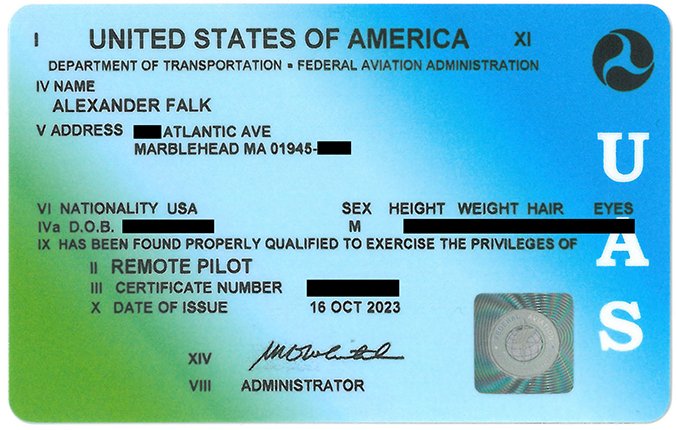Drones (sUAS)
Notice regarding drone (sUAS) usage during the Marblehead Fireworks
A. Recreational Drone Usage
For recreational drone owners/pilots flying under USC 44809 (Exception for limited recreational operations of unmanned aircraft):
As a recreational drone pilot, you are required to follow the safety guidelines of an FAA-recognized Community Based Organization (CBO).
All such safety guidelines include a sentence similar to the following:
Warning
“I will avoid flying directly over unprotected people,
moving vehicles, and occupied structures.”

Therefore, during major events where likely all these conditions will exist, like the Marblehead Fireworks display, you are not permitted to fly your drone over the harbor, where boats are operating as moving vehicles, and you are not allowed to fly over boats at anchor or at a mooring, as there will be unprotected people on board. Furthermore, you are not allowed to fly over any of the public parks, such as Fort Sewall, Crocker Park, Chandler Hovey Park, etc. as there will be large gatherings of unprotected people in those areas.
To sum it up, please leave your drone at home!
Thank you!
B. Commercial Drone Usage

For commercial drone owners and remote pilots operating under CFR Title 14 / Chapter I / Subchapter F / Part 107 and being in possession of a FAA remote pilot certificate with a small UAS rating (see example image on the right):
Please keep in mind the following requirements that will govern your operation:
- Subpart D – Operations Over Human Beings contains several restrictions that may impact your ability to operate a drone during the Marblehead Harbor Illumination and Fireworks, because you will be operating over an “Open Air Assembly” (the FAA specifically lists as examples of an Open Air Assembly “Parks and Beaches during certain events” and the Marblehead Fireworks fall exactly into that category):
Categories 1-4
- To conduct § 107.110 Category 1 operations, the RPIC must use a small UA that:
- weighs 0.55 lbs or less on takeoff and throughout the duration of the flight
- does not contain any exposed rotating parts that would lacerate human skins upon impact
- To operate over open-air assemblies of human beings, the UAS must meet the Remote ID requirements (§ 89.110 or § 89.115(a)) Please note: very few commercially available sUAS weigh less than 0.55 lbs, so most likely, as a commercial drone operator, you will not fall under Category 1!
- To conduct Category 2 operations (§ 107.115 and § 107.120), the RPIC must use a small UA that:
- must not cause injury to a human being equivalent to 11 foot-pounds of kinetic energy upon impact
- does not contain any exposed rotating parts that would lacerate human skins upon impact
- does not contain safety defects
- is labeled as Category 2
- is listed with an FAA-accepted Declaration of Compliance
- To operate over open-air assemblies of human beings, the UAS must meet the Remote ID requirements (§ 89.110 or § 89.115(a))
- Category 3 operations (§ 107.125) are not permitted over open-air assemblies of human beings
- Category 4 (§ 107.140) is likely not applicable to you, as these drones are larger UAS that require a Part 21 Airworthiness Certificate and must have documented systems for maintenance and inspection
-
§ 107.145 Operations over moving vehicles is prohibited for Category 1, 2, and 3 operations unless (a) those vehicles are within a closed- or restricted-access site and (b) all human beings located inside those vehicles are on notice that a small UA may fly over them. All boats in the harbor are moving vehicles (even if they are at anchor or at a mooring, they are still moving with the wind and currents!) and the harbor is not a closed- or restricted-access site, and neither are all people in the harbor on notice.
-
§ 107.29 Operation at night contains two requirements that you also need to fulfill:
-
The remote pilot in command (RPIC) of the small unmanned aircraft has completed an initial knowledge test or training, as applicable, under § 107.65 after April 6, 2021; and
-
The small unmanned aircraft has lighted anti-collision lighting visible for at least 3 statute miles that has a flash rate sufficient to avoid a collision.
-
To sum it up, for operations under Category 1 or 2 over any of the public parks surrounding the harbor you will be operating over an open-air assembly of human beings, and, therefore, have to fulfill a series of important requirements (see above and in the Part 107 regulation). Furthermore, for operations under Category 1, 2, or 3, you are not allowed to fly over moving vehicles under § 107.145, and are thus not allowed to fly over any of the waters in Marblehead harbor, unless you have requested and have been granted a § 107.145 waiver under Subpart E by the FAA.
If we see drones operating above the harbor, law enforcement may use the Remote-ID information from your sUAS to locate the operator and we may ask you to produce any or all of the following documentation, which you are required to produce upon request by the authorities:
-
Your FAA remote pilot certificate
-
Your sUAS registration, and the registration# label/sticker on your sUAS
-
The FAA-accepted Declaration of Compliance and the Category 2 label/sticker on your sUAS (if conducting Category 2 operations)
-
The Airworthiness Certificate issued under Part 21 (if conducting Category 4 operations)
-
Your § 107.145 waiver, if you are operating over the harbor and thus are engaged in flight over moving vehicles
If you fail to provide this information and/or your drone does not have the required labels (especially Category 2 label for operation under Category 2!) or prop guards (“does not contain any exposed rotating parts that would lacerate human skins upon impact”), your drone may be confiscated for further investigation by authorities and we may refer this matter to the FAA Boston Chief of Operations.